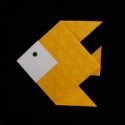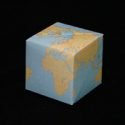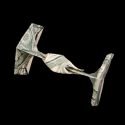Origami Science
Origami-Like Techniques Used in Advanced Technologies.
You will be surprised to know that paper folding ideas are used in technically advanced science projects. Some projects use bona fide origami folding techniques in the their work. However, in some cases, the term “origami” is used even when their is minimal folding involved.
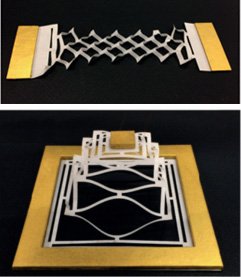
August 2015: Researchers Blees et al. from Cornell University have created a flexible graphene structure using a design from this web site, the Origami Resource Center (we have finally made it into Nature!).
Graphene is a hexagonal lattice of carbon atoms arranged as a one-atom-layer sheet. It is 200 tiimes stronger than steel but it is also very brittle. Graphene conducts electricity so it is often used in the production of semiconductor, battery components, and the like.
Concepts from a simple kirigami design were used on the carbon sheets to create “graphene kirigami sheets” which are thousands of times more flexible than the original graphene. In the future, one-atom thick graphene kirigami sheets can be used to create small structures such as micro springs and hinges which are both resilient and flexible. Talk about nano technology!
At a larger scale, researchers from the University of Michigan have made a kirigami battery (based on this article) which can be incorporated into wearable electronics.
- read abstract and full article
- watch video (right panel)
- see humble kirigami designs

Researchers at Brigham Young University, National Science Foundation, NASA’s Jet Propulsion Laboratory, and origami expert Robert Lang designed a space array which can be folded compactly and then deployed while in outer space. When opened, the proposed disk-like array is 25 meters in diameter (82 feet) but when folded origami-style, it is only 2.7 meter (8.8 feet). Large-array-in-narrow-rocket problem solved!
Not so fast. It takes a lot of time and money to make a 25 meter solar array so the project is currently in the form of a 20th scale prototype. Read article or see video.
This solar array is similar to the origami Flasher by Jeremy Shafer but it’s not the first time that origami has been used in space technology. In 2002, Robert Lang designed “Eyeglass”, a foldable space telescope; a full-scale model has not been made or launched (read more). Back in 1995, Japanese scientists designed a “Miura-ori” solar array which was successfully launched and deployed (read more).

Researchers from Arizona State University constructed a paper-based lithium-ion battery which can be folded Miuri-Ori style (the famous Mori-ori map fold). Not only is this space efficient, the folding of the flat sheet into a compact bundle generated a 14-fold increase in areal energy density (“areal” means increase in energy based on its area).
Easy to read article here or abstract ACS Publications. Published in Nano Lett., 2013, 13 (10)
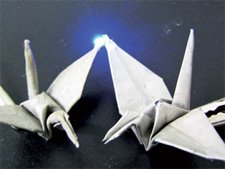
Antennas are needed in all electronic devices which receive & send information. People have been able to make flexible antennas using plastics (pretty good) and paper (not so good). Nogi et al perfected the paper antenna by using fibrillated cellulose nanofibers to make a smooth-surface paper. Next, silver nanowires were printed on the super-smooth paper to make a highly foldable nanopaper antenna.
[Photo: paper cranes made with silver-imprinted nanopaper. The LEDs light-
up indicating that the paper cranes
can conduct electricity. Note the alligator-clip pinching the crane on the right.]
How is this going to help us in the future? Well, foldable antennas can lead to flexible electronic gadgets – these would be smaller, less stiff, and less plastic-y. Imagine communication devices embedded right on your shirt sleeve or on your neck tie. Alternatively, the properties of the gadget may change depending on how you fold the antenna: fold it one way and it’ll take your temperature, fold it the other way and it’ll take your blood pressure. The possibilities are endless.
Read abstract from Nanoscale.

“Waza” in Japanese means “art” or “technique”. Photos by danaoshiro.
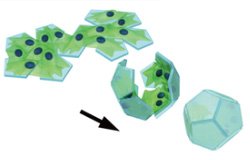
December 2012: Researchers Kuribayashi-Shigetomi et al. from the University of Tokyo placed living cells on microplates. When the adhered cells are induced to contract, they cause the microplates to fold into cubes, dodecahedra, and spiral tubes.
They call this technology “Cell Origami”. Actomyosin interactions and actin polymerization allow the cells to self-fold and produce micro structures without the use of hinges or special materials.
Read article or watch video.
In terms of science, this development may lead to medical devices which can be activated to fold while inside a body. In terms of origami, the process is not that different than collapsing a crease pattern into the finished origami model as shown with Fujimoto’s Cube.

Photo: origami tessellations showing a single galaxy (left) or six galaxies (right).
Pattern is essentially the Tiled Hexagons by origami artist, Eric Gjerde.
The researchers compared origami tessellations to the formation of cosmic structures from dark matter. Dark-matter is described as a “flat sheet” and the force of gravity “folds” the dark matter in a way similar to paper folding in origami. The folds in dark-matter tessellate into stream regions which can be conceptualized through origami tessellations. See abstracts here and here.
Business Card Origami Fractal
September, 2012: Most people know fractals as swirly computer-generated images. With origami, engineer Jeannine Mosely and organizers of the Institute For Figuring create the
Mosely Snowflake Sponge. It was made with 49,000 business cards and it represents a 3D fractal. This was a 7-month long, campus-wide project based in the University of Southern California.
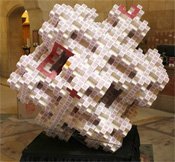
Level-3 Mosely Snowflake Sponge
– is composed of 18 Level-2 units;
– each level-2 unit is composed of 18 level-1 units;
– each level-1 unit is composed of 18 cubes;
– each cube is made with 6 business cards.
Connector cards are needed to keep the cubes together without glue or tape.
grand total = 49,000 business cards.
[Photo: Level-3 Mosely Snowflake Sponge: a physical representation of a fractal.]
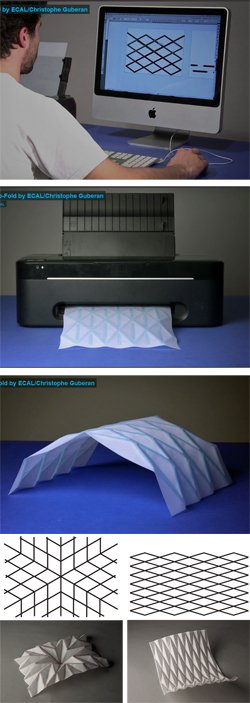
ink/water imprinted crease patterns cause self-folding.
April, 2012: Industrial Design student, Christophe Guberan, from Ecole Cantonale d’art de Lausanne can make a sheet of paper self-fold when water/ink is printed on the paper.
The process is as simple as 1-2-3:
1) design the crease pattern on a computer,
2) print the pattern on a sheet of tracing paper,
3) watch the paper fold itself along the crease lines.
The printer is fitted with a special mix of water and ink. As the water/ink mixture dries, it causes the paper to buckle and fold along the printed crease lines thereby transforming a 2D sheet of paper sheet into a 3D structure with volume.
I cannot imagine it getting any easier than this!

Fast forward 6 years (Feb, 2012) and these smiley faces have a real-life application. Wyss Institute (Harvard) researcher Shawn Douglas and colleagues have been able to use Origami DNA to create 3D shapes such as cubes and boxes. More importantly, Douglas was able to use Origami DNA techniques to create a clam-like cage which could carry and deliver drugs to specific target cells. The clam-like cage (nanorobots) had “locks” which unzip when a target cell is found, thereby releasing drugs locally.
Results are promising: when loaded with chemicals which kill cancer cells, the Origami DNA nanobots delivered drugs so that half of the leukemia cells were destroyed whereas none of the normal cells were harmed.
So… where’s the “origami” here? Sorry, not much real origami here except for the term “Origami DNA”. However, you can fold a piece of paper to look like double helix DNA here (T Yenn) or here.

Harvard researchers Sreetharan et al. have developed a way to mass-produce small robots quickly. The Monolithic Bee is a 2.4 mm tall and is made in a one-step-pop-up move requiring less than one second. Not really origami – but definitely origami-inspired. Read more from Havard.
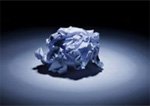
The office paper-ball is familiar to us all, but did you know that no matter how you squeeze the structure, it will remain predominantly (90%) air? Those in shipping and receiving will agree that scrunched up papers are great as packing material. This might be because paper balls absorb vibrations thereby giving them excellent cushioning power. The humble origami snowball resists X-ray analysis so much of its properties is still a mystery. Read more from New Scientist.
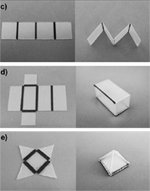
The idea is this: black absorbs more energy than pale colors so the black lines will shrink faster than the surrounding white areas. You can change the angle of the fold by changing the width of the black lines. You can achieve valley or mountain folds by printing the lines on the top or bottom side of the polymer sheet. It’s so easy – the possibilities are endless!
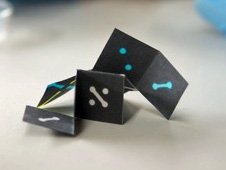
The idea is this:
– reagents (biomarkers) are placed on sections of the oPAD,
– the oPAD is folded into a multilayer stack,
– a biological sample is applied,
– wait for the sample to penetrate all layers,
– unfold the oPAD and analyze.
The process requires no special skills except folding/unfolding the oPAD, and analysis is simple (such as a change in color).

The oPAD is made of paper and costs about 10 cents to make. The panels of the oPAD can test for different diseases, or can be different methods of testing for one disease. This origami inspired diagnostic device is currently in the clinical stages of development.
- Read abstract.
- Watch video
- Photos from www.utexas.edu and pubs.acs.org.
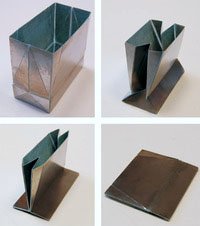
In March 2011, engineers Zhong You and Weina Wu (University of Oxford, UK) designed a collapse-able, origami grocery bag made out of steel. As you might expect, this origami grocery bag can fold and unfold from a functional box-like container into flat sheets of metal.
Shouldn’t this origami grocery bag be in the Origami in the Kitchen section rather than Origami in Science? You may be right, but there’s more to this grocery bag than what meets the eye.
Currently, rigid containers such as cardboard boxes can only be folded flat if the top and bottom panels are both left open. This is tiresome because you need to reconstruct the bottom before the box can be used. Here, You and Wu have developed a steel (rigid) container which can be folded down flat without opening the bottom panel. This design can save a lot of time especially in the manufacturing & packing industry.
Can you imagine a box the size of a house being folded and unfolded like this origami grocery bag? You decide: science, science fiction, or kitchen aids?
- easy to read version of this story here
- abstract from Proceedings of the Royal Society
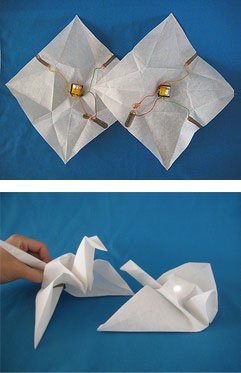
Leave it to MIT to convert traditional origami into electronic origami. Shown in videos are traditional origami birds fitted with wires and batteries. In one, the bird can flap its wings by itself thanks to memory wire. In the second video, two birds communicate: when one bird flaps its wings, its partner lights up.
- Electronic origami created by Jie Qi who is a
- member of the High Low Tech group at the MIT Media lab.
- See her fabulous electronic pop up book here.
- electric origami can also be seen in vimeo
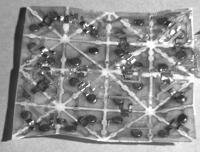
In the June 2, 2010 issue of PNAS, researchers Hawkes et al report the development of a sheet of composite material which can fold itself. The flat sheet is composed of triangular panels lined with foil actuators (motors). When an electric current is passed through the sheet, select edges expand and/or contract causing the sheet to fold into origami-like boats & planes. Once the desired shape is realized, the shape is held in place with magnets.
This seemingly simple procedure is significant because it requires that a material interacts with its environment and rearrange itself according to specified shapes/stiffness. This may lead to, for example, a measuring cup which folds itself according to the amount and/or temperature of the liquid which it holds.

- Read paper abstract

February 16, 2010; Applied Physics Letters.
Conventional solar panels are flat and do not capture the sun’s rays efficiently unless they were tilted to track the movement of the sun. MIT professor Jeffrey Grossman propose a method of folding solar cell systems such that they could produce a constant amount of power regardless of the sun’s movements. Some of these folded solar cell systems are 2½ times more efficient than the traditional flat arrays.
- read article from Live Science
Dr Grossman comments that his work is at a very early stage of development and the term “origami” was pressed upon him by the media.
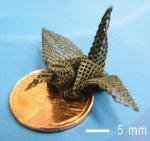
In the April, 2009 issue of Advanced Materials, Jennifer Lewis and her research team (U of Illinois) developed a new method for fabricating small, complex 3D structures which are needed in biomedical devices. The novel method involves printing titanium hydride ink into flat sheets then folding the sheets into intricate designs.
Initially, the titanium sheets dried and cracked but researchers overcame the problem by using wet folding ideas from origami. A mix of fast- and slow-drying solvents were used so that the titanium sheets dried partially but were still flexible enough to fold without cracking. Researchers said, “marriage of printing and origami techniques allows for greater structural complexity”.
- see photos here and abstract here.

In January 2007, Eric Tremblay and Joseph Ford from the University of California in San Diego have made an ultrathin, high-resolution Origami Lens. The lens is very thin and is 7 times more powerful that conventional camera lenses.
Typically, camera lenses use many parts to bend and focus light. The Origami Lens replaces the many parts of a conventional camera lens with one optical system; this makes the lens thinner.
The Origami Lens is made of a crystal which is diamond-cut so that the light travels in a zig-zag manner analogous to the way paper is pleated in origami. Note: the lens itself is not folded, but the optical path is folded.
- Read the news release from UCSD.
- Order the entire publication from Applied Optics.
- Read Robert Lang’s article on Optigami; folding of light path
- Photo from E Tremblay and University of California in San Diego.
  |
– 4 small robotic arms controlled by joystick & foot petals, – a 3-dimensional magnification visual system, and a – computer screen console. These elements allow surgeons to perform small scale operations precisely. So, what does this have to do with origami?November 2006: This video shows the dexterity of the da Vinci robot and fine detail work capable when performed by a skilled surgeon. The humble paper crane is used to prove the value of a high-tech, $1.75 million dollar machine.March 2011: Another example: a paper airplane the size of a penny is made by a Seattle doctor via da Vinci Robot. This video shows how the da Vinci pincers are manipulated with finger cap adaptors. |
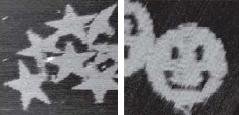
The idea is simple: DNA is folded in a back and forth manner and then held together with smaller strands of DNA at key positions. This works because of Watson and Crick pairing: recall biology 101 rule that A bonds with T and C bonds with G.
Photo shows origami DNA shapes photographed with atomic force microscope.
Why is this important to us? Well, it may lead to other molecular self assembly of nanostructures. Note that these DNA shapes are about 100nm in diameter – that’s pretty small because an average germ is 1000nm.
- see research abstract
- see more photos
- fold an origami DNA here (T Yenn) or here.

In 2003, Zhong You and Kaori Kuribayashi from the University of Oxford developed an origami stent which may be used to enlarge clogged arteries and veins. The waterbomb base from origami was used to design the origami stent.
A stent is a tube which can be collapse into a smaller size. Using a balloon catheter, the stent is maneuvered through the patients veins/arteries to the clot site. When the balloon is inflated, the stent is expanded to a larger diameter, thereby opening the vein/artery for better blood flow. Depending on the application, the tissue may grow over the stent and it remains in the patient permanently. By 2005, a self-deployable origami stent was developed.
- See another photo of origami stent.
- See image of stent in a vein.
- Read article about Origami Stent by Z You and K Kuribayashi
- Buy article about self deployable origami stent from Science Direct
- Photo from http://www-civil.eng.ox.ac.uk/people/zy.html (Zhong You) and http://www-civil.eng.ox.ac.uk/publications/theses/kurib.html (Kaori Kuribayashi)

In order to study galaxies and astronomical events that are far away, a large space telescope is needed. However, giant telescopes cannot be shipped into space due to the size constraints of rockets and shuttles.
Professional origami artist, Robert Lang helped scientists at the Lawrence Livermore National Laboratory (Livermore, California) design a method for folding a space telescope so that it can be packed into a space shuttle and then easily deployed when in space. The foldable telescopic lens is called “Eyeglass”.
In early 2002, a telescopic lens measuring over 3 meters in diameter was constructed. When folded origami style, it was 1.2-meter in diameter and shaped like a cylinder. By early 2004, a 5-meter prototype lens was constructed and shown to concentrate light as expected.
In the future, it may be possible to fold 100-meter telescope lenses into 3-meter diameter cylinders and have these delivered into space – all thanks to origami.
Photo: Space telescope “Eyeglass” can be folded origami style from a flat disk (bottom right) into a smaller cylinder (top left). Credit is given to the University of California, Lawrence Livermore National Laboratory, and the Department of Energy under whose auspices the work was performed.
- Read more about Eyeglass from LLNL.
- See photos of the 3.3 and 5 meter space telescope lenses.
- See photos of a telescope lens being folded (E Demaine’s site).
- Read Robert Lang’s commentary regarding Eyeglass project.
Solar Sails in Space Flight Unit In March of 1995, Japanese scientists used origami concepts to pack and deploy a solar power array in the research vessel called Space Flight Unit (SFU). On Earth, the solar array was folded into a compact parallelogram, and then in space, it was expanded into a solar sail. The method of folding the solar panels is called “Miura-ori”, in honor of Koryo Miura, a professor in Tokyo University, who developed the fold.
- Read about the SFU space mission.
- SFU spec data
- More photos of SFU.
- Photo provided by Japan Aerospace Exploration Agency (JAXA)
The Miura-ori (translation = Miura-fold) is famous in map folding. The Miura-ori allows a square piece of paper to be folded in such a way that it can be opened (in one motion) by pulling at two opposite corners. As well, a Miura-ori folded map is less likely to tear at the crease junctions. An easy to use road map – now that’s origami science!

- See an animated Miura-ori map or Youtube video of miura ori map fold and unfold.
- Fold a Miura-ori map yourself using a diagram by Tom Hull.
- Photo from British Origami Society (BOS)
Airbags in Cars:
A German company, EASi Engineering, was interested in finding a better way to pack airbags into car steering wheels. Professional origami artists, Robert Lang, helped design an algorithm which will allow computer simulations of airbag folding and deployment. This allowed the company to evaluate the efficiency of the airbags without actually doing a crash test. Saves money, saves time, saves lives. What could be better?Research is ongoing. Read Robert Lang’s commentaries on the airbag project.
Image from US Zeitgeist 2010 presentation.

Other Origami Science Applications Crumple Zones in Cars:
Most cars have pre-designated crumple zones at the front and back of the car. These are engineered zones which will collapse during a collision. Folding at the crumple zones will absorb the energy of the impact and potentially save the lives of the passengers. In conjunction with the Nissan Motor Company, Japanese scientist, Ichiro Hagiwara, uses his knowledge of origami to design a fold pattern that will absorb maximum energy during impact. Research in progress.
More Origami Science Stuff
- examples of useful origami from UCL 3C41 Research Group
- read Origami Science in Trends in Japan
- article by S Krishnan in Don Cohen’s site
Do you know of any more origami sightings? Let us know!
- go to Home Page
- go to Site Map
- go to Free Origami Instructions
Many of these images are from the internet: they have gone viral without clear indication who is the rightful owner of the photo. Let us know if you want your photo removed from this site.









